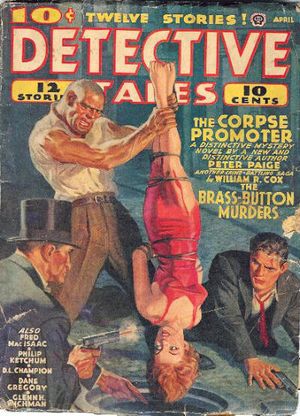Detective fiction
Detective fiction is a sub-genre of crime fiction and mystery fiction in which an investigator (often a detective), either professional or amateur, investigates a crime, often murder.
The Golden Age
The Golden Age proper is in practice usually taken to refer to a type of fiction which was predominant in the 1920s and 1930s but had been written since at least 1911 and is still being written - though in much smaller numbers - today. In his history of the detective story, Bloody Murder: From the Detective Story to the Crime Novel, the author Julian Symons heads two chapters devoted to the Golden Age as "the Twenties" and "the Thirties". Symons notes that Philip Van Doren Stern's article, "The Case of the Corpse in the Blind Alley" (1941)[2] "could serve ... as an obituary for the Golden Age."
Many of the authors of the Golden Age were British: Margery Allingham (1904–1966), Anthony Berkeley (aka Francis Iles) (1893–1971), Agatha Christie (1890–1976), Freeman Wills Crofts (1879–1957), R. Austin Freeman (1862–1943), Michael Innes (1906–1993), Philip MacDonald (1900–1980), Dorothy L. Sayers (1893–1957), Josephine Tey (1896–1952), and many more. Ngaio Marsh (1895–1982) was from New Zealand, but her detective Roderick Alleyn was also British. Georges Simenon was from Belgium and wrote in French. Some of them, such as John Dickson Carr, Ellery Queen, and S. S. Van Dine, were American but had similar styles. Others, such as Raymond Chandler and Dashiell Hammett, had a more hard-boiled, American style.
Description of the genre
Certain conventions and clichés were established that limited any surprises on the part of the reader to the details of the plot and, primarily, to the identity of the murderer. The majority of novels of that era were "whodunits", and several authors excelled, after misleading their readers successfully, in revealing the least likely suspect convincingly as the villain. There was also a predilection for certain casts of characters and certain settings, with the secluded English country house and its upper-class inhabitants being very common.
The rules of the game – and Golden Age mysteries were considered games – were codified in 1929 by Ronald Knox. According to Knox, a detective story
"must have as its main interest the unravelling of a mystery; a mystery whose elements are clearly presented to the reader at an early stage in the proceedings, and whose nature is such as to arouse curiosity, a curiosity which is gratified at the end." Knox's "Ten Commandments" (or "Decalogue") are as follows:
- The criminal must be mentioned in the early part of the story, but must not be anyone whose thoughts the reader has been allowed to know.
- All supernatural or preternatural agencies are ruled out as a matter of course.
- Any secret room or passage is forbidden.
- No hitherto undiscovered poisons may be used, nor any appliance which will need a long scientific explanation at the end.
- No Chinaman must figure in the story.
- No accident must ever help the detective, nor must he ever have an unaccountable intuition which proves to be right.
- The detective himself must not commit the crime.
- The detective is bound to declare any clues which he may discover.
- The stupid friend of the detective, the Watson, must not conceal from the reader any thoughts which pass through his mind: his intelligence must be slightly, but very slightly, below that of the average reader.
- Twin brothers, and doubles generally, must not appear unless we have been duly prepared for them.
A similar but more detailed list of prerequisites was prepared by S. S. Van Dine in an article entitled "Twenty Rules for Writing Detective Stories" which appeared in The American Magazine in September 1928. They are commonly referred to as Van Dine's Commandments.
Why is this article included on the SM-201 site?
The covers of most detective magazines included lurid or horrorific pictures or drawings. (See the cover of "Detective Tales" magazine from April, 1940 [to the right] as an example.)
Publishers created these covers in an effort to draw the attention of potential buyers.
The covers have helped the careers of some of the world's finest pin-up artists. Among the most famous pulp artists were Walter Baumhofer, Earle K. Bergey, Margaret Brundage, Edd Cartier, Virgil Finlay, Earl Mayan, Frank R. Paul, Norman Saunders and Nick Eggenhofer.
See also [ Pinup artist FAQ ]
- More information is available at [ Wikipedia:Detective_fiction ]
Chat rooms • What links here • Copyright info • Contact information • Category:Root
